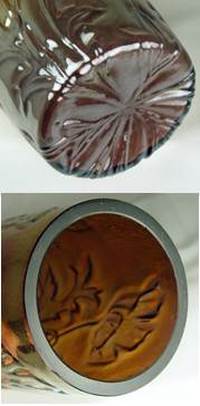Fåglaviks Glasbruk (Faglaviks Glass Works), Sweden
Faglaviks Glass Works (Fåglaviks Glasbruk) was founded in 1874 by Anders Magnus Andersson – a realisation of a long-held dream. It used local peat for fuel, local sand deposits and railway links. The main furnace used a German system, and many itinerant German / Bohemian workers were employed.
Early glass production included bottles (for perfume and medicine), lighting, vases and tableware and just eight years after they began, the factory won a silver medal at the International Fisheries Exhibition in Edinburgh for the production of glass floats for fishing nets!
By the early 1900s, Faglaviks was among the top five Swedish glass works … and among its output was Carnival Glass. The business struggled in later years, eventually becoming bankrupt and closing in 1980.
We discovered Faglaviks and its contribution to the Carnival Glass scene, during our research for our e-books, the Trilogy on Nordic Carnival (from Sweden, Finland and Norway). Iridescence was used on various items at Faglaviks, including vases, bowls, candlesticks and (interestingly) blown flagpole tops and garden “balls”.
Undoubtedly, Faglaviks was not a "volume" producer of Carnival Glass and the items known so far are relatively rare pieces. They are amazing discoveries, and almost certainly, there is more to come. The Carnival colours known to have been made by Faglaviks are green, marigold, purple / amethyst, and most recently thanks to Christina Katsikas, vaseline (see later).
Faglaviks patterns discovered so far: Palms and Ribs, Poppy Spray, Spiral and Susanne.
Poppy Spray
Our initial research into Faglaviks solved a mystery that had tantalised us for many years … the maker of the Poppy Spray vase was Faglaviks.
This was the key discovery, and it led us to the revelation that other Carnival Glass items were indeed made by that factory. The Poppy Spray vase is shown in amethyst in two very different shapes below (left). Its distinctive and unusual characteristics include a moulded design that goes all over the base and a ground top - see below, centre.
Left: amethyst Poppy Spray vases in two different shapes. Centre: green Poppy Spray vase courtesy of Burns Auctions.
Right: typical Faglaviks characteristics - a pattern that continues from the sides and onto the base, and a ground top.
Right: typical Faglaviks characteristics - a pattern that continues from the sides and onto the base, and a ground top.
Spiral
Spiral (the original Faglaviks name, illustrated in their 1912 catalogue) is an abstract design featuring a loose, coiling spiral.
|
Like the Poppy Spray pattern, the moulded design is continued all over the base, and the top of the vase is ground.
It has been reported so far in a small vase 4.5 inches (11.5 cm) tall with flared top and bulbous central section (below), and a tapering cylinder vase (shown right courtesy of Ingemar Nilsson); note the similarity to Poppy Spray vases. |
|
Both of the above vases are in amethyst, and marigold is also know. However, there has been a further discovery - Faglaviks also made vaseline Carnival.
Shown below and on the right are pictures of two Spiral vases. The vase on the left of each pair shown is a dark marigold, whereas the one on its right is a lighter marigold. You can see the vaseline colour on the ground/cut rim of the vase, but there can be no doubt about it when viewed under a UV light - that it has a very strong vaseline glow! All images are courtesy of Greg Dilian.
|
|
Susanne In our 2012 ebook Carnival Glass from Sweden, we showed an unusual 9.5 inch, amethyst vase in a pattern that we named "Susanne" after the Swedish lady who found it - Susanne Berg. Vertical and horizontal ribs are the predominant features on this blow moulded vase, giving a fine "waffle" effect (the vertical ribs are a little more dominant). As with other pieces from Faglaviks, the moulded design is continued all over the base, and the top of the vase is ground. Pictures of this tall Susanne vase are courtesy of Susanne Berg. Another example of the Susanne vase has been reported in a different shape - it's shorter and a more bulbous shape. |












